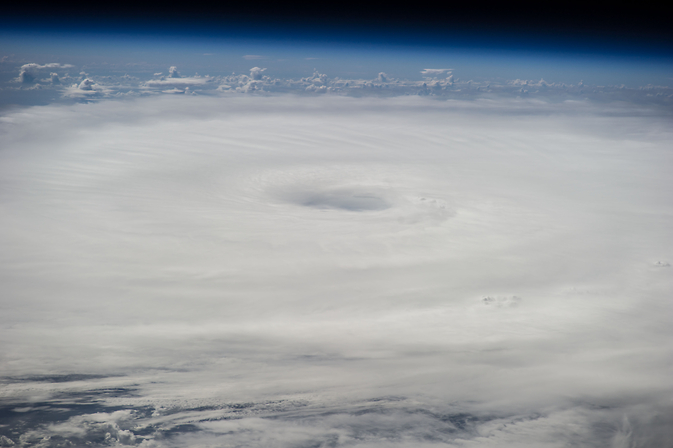NASA Sees Hurricane Edouard Far From U.S., But Creating Rough Surf

This photograph of Hurricane Edouard was taken from the International Space Station on Sept. 17, 2014. Image Credit: NASA JSC/ISS
On Sept. 17, the National Hurricane Center noted “Swells from Edouard will affect portions of the east coast of the United States north of Florida beginning today. These swells will likely cause life-threatening rip current conditions along most of the United States east coast for the next couple of days.”
When NASA's Aqua satellite passed over Hurricane Edouard on Sept. 16 the MODIS instrument captured a visible image of the storm that it still maintained its eye. Bands of powerful thunderstorms were spinning into the center from the north and south.
At 11 a.m. EDT on Sept. 17, Edouard's maximum sustained winds were near 90 mph (150 kph) and weakening is forecast. The eye of Hurricane Edouard was located near latitude 36.4 north and longitude 53.3 west. Edouard is moving toward the northeast near 24 mph (39 kph) and turn east on Sept. 18. The latest minimum central pressure reported by a NOAA Hurricane Hunter aircraft is 958 millibars.
The National Hurricane Center expects rapid weakening on Sept. 18 with Edouard dropping in intensity to a tropical storm.
Rob Gutro
NASA's Goddard Space Flight Center
Media Contact
More Information:
http://www.nasa.gov/content/goddard/td6-atlantic-ocean/All latest news from the category: Earth Sciences
Earth Sciences (also referred to as Geosciences), which deals with basic issues surrounding our planet, plays a vital role in the area of energy and raw materials supply.
Earth Sciences comprises subjects such as geology, geography, geological informatics, paleontology, mineralogy, petrography, crystallography, geophysics, geodesy, glaciology, cartography, photogrammetry, meteorology and seismology, early-warning systems, earthquake research and polar research.
Newest articles

Sea slugs inspire highly stretchable biomedical sensor
USC Viterbi School of Engineering researcher Hangbo Zhao presents findings on highly stretchable and customizable microneedles for application in fields including neuroscience, tissue engineering, and wearable bioelectronics. The revolution in…

Twisting and binding matter waves with photons in a cavity
Precisely measuring the energy states of individual atoms has been a historical challenge for physicists due to atomic recoil. When an atom interacts with a photon, the atom “recoils” in…

Nanotubes, nanoparticles, and antibodies detect tiny amounts of fentanyl
New sensor is six orders of magnitude more sensitive than the next best thing. A research team at Pitt led by Alexander Star, a chemistry professor in the Kenneth P. Dietrich…





















